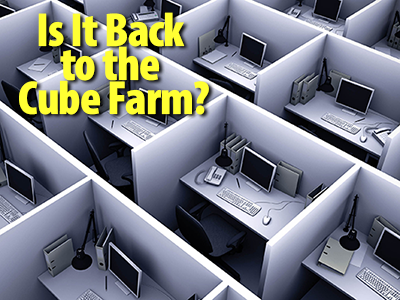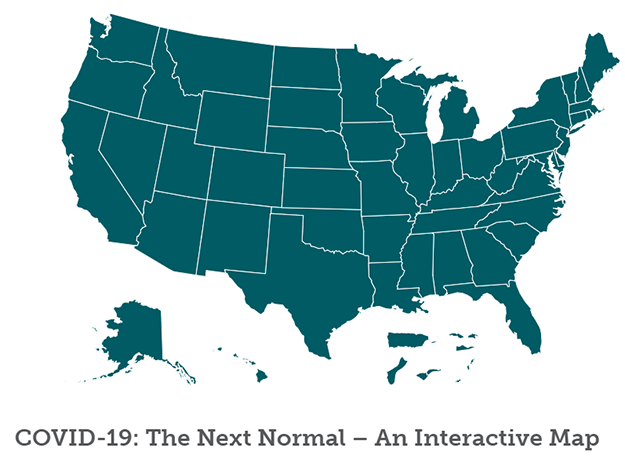

Returning to Work in a COVID-era World
Leveraging emerging technology: Employer, employee, safety & productivity
Littler’s Natalie Pierce and Chase Perkins take a look from an employer’s perspective on leveraging technology as millions finally return to COVID-era workplaces.
Marketplace’s Molly Wood & Kai Ryssdal take a look from an employee’s perspective
CGTN-America takes a look at the new-era, physical layout for COVID-era workplaces.
Employer Perspective
Pierce & Perkins (Littler): Let us take a look
“Returning millions of employees safely back to work requires planning and precision in execution. Employers face myriad potential legal challenges. Specifically, workplace-acquired COVID-19 might lead to workers’ compensation claims and claims related to lax compliance with safety requirements, including provision of personal protective equipment (PPE).

“On the other hand, going too far to prevent injury by infection could result in employers’ facing privacy and discrimination-related claims. The Equal Employment Opportunity Commission issued guidance earlier this year that employers may administer COVID-19 testing to employees reentering the workplace, thus emphasizing the ability and need for striking the right balance.
“As the country opens back up, minimizing surface contact rates, testing, and maximizing space between employees will have many companies reconfiguring workspaces and looking to emergent solutions. Let us look at a few.”
HR viewpoint
“To mitigate associated legal risks, HR departments should work with experienced legal counsel to ensure appropriate technology assessment and evaluation procedures are followed before its adoption and throughout the technology’s life cycle.
“While employee-focused proximity sensors, AI-powered monitoring tools, and contact tracing applications may provide new capabilities to enhance workplace safety, it is imperative for employers to understand the risks incurred when adopting new technology.”
The tech and its cautions
“Thermographic cameras—also known as infrared or thermal imaging cameras—can detect body and object heat signatures. Thermal imagery is the operative technology enabling hand-held, noncontact thermometers, the variant of the technology that has been most widely deployed at workplace points of entry.
“When layered with machine vision software, thermal imaging can be used for automated detection and assessment of individuals within groups. As businesses begin to reopen, employers ranging from food production to fulfillment centers to grocers and casinos are increasingly modifying workplace safety procedures and leveraging thermal imaging technology to actively mitigate the introduction and spread of the coronavirus in the workplace.
“Measuring an employee’s body temperature, whether via a handheld thermometer or telescopic thermal imaging camera, is considered a medical exam and employers need to maintain confidentiality of the information.”
Tech tools
More robots— “Warehouses and hospitals, and grocers alike are leveraging robotics to increase workplace safety. Industries are adopting autonomous mobile robots at an accelerated pace to help with moving materials between workspaces; for sanitation and cleaning; and for delivery of essential tools, food, and medicines for battling the virus.
“As airlines start booking more brave passengers, the use of PPE and heavy plane sanitation will be the norm. Dimer’s GermFalcon UV-C robots, designed to disinfect airplanes, and Avalon Biomedical’s vaporized hydrogen peroxide robot, for deep cleaning of airports, are examples of robots delivering greater safety and efficiency.
“As more hotels and restaurants open post-pandemic, expect to see continued adoption of robots for check-ins and room service deliveries. Robots are making safer the lives of essential workers and the customers and patients they serve.”
“Companies—seeking to adopt new technologies to improve workplace safety and operational integrity should conduct periodic evaluations throughout the life cycle of a technology’s use to ensure maximum compliance of applicable laws in every jurisdiction in which they operate. Recurring examination of emerging technology in the workplace is particularly important in the context of data-driven HR decisions and biometric information collection.
“Below is a high-level overview of pressing initial evaluation questions that will affect the complexity of the legal compliance and validation process of new technology in the workplace: e.g. proximity sensors, thermal imaging scanners, AI-powered biometric analytics, and contact tracing tools.”
HR should think about:
- What data sources have been or will be used?
- What forms of internal and vendor documentation exist relating to the applicable technology?
- Does the technology analyze, collect, or store employee biometric or personal identifiable information? Will the employee data be obtained voluntarily and with the employees’ informed consent?
- What roles do various employees (e.g., HR staff, supervisors, and legal) play in collecting or acting upon data-driven decisions?
- If supervisors or other individuals with decision-making authority are involved, what steps are taken to ensure they did not gain access to sensitive or protected information regarding employees?
- To what extent has the technology been evaluated to comply with applicable discrimination, employee privacy, and data protection laws?
- Has the company structured and implemented a recurring technology monitoring plan to periodically check to ensure its use is in accordance with best practices?
Employee Perspective
Kai Ryssdal & Molly Wood Marketplace Podcast:
Getting Back to Work: What Will It Look Like?
Guest: Chris Calabrese
VP, Policy
Center for Democracy & Technology
Topics:
- Surveillance & privacy issues
- Fever monitoring/thermal cameras
- Contact tracing
- Sensors
- Backend databases to track data
- Movement tracking

Physical Layout of Workplaces
CGTN America: What Changes to My Workplace
Topics:
- Change in mindset for employee
- Major upheaval to reconfigure
- May never return to what was “normal”
- Will it be return to the cube farm?
- One way, office traffic flow and elevators
- Goodbye “open office” and crowded meeting rooms
- Hello Plexiglass everywhere
- How Cushman & Wakefield returned 1M to work in China
Littler's Reopening Map
Which States Are Reopening: When, How & Details
Littler’s State-by-State Interactive Reopening Guide
Click to go to Littler’s State-by-State Interactive Reopening Guide where each state on the map will display an overview of the state’s reopening posture, including a list of the sectors permitted to reopen and the accompanying executive orders and official guidance describing the applicable health and safety requirements.

